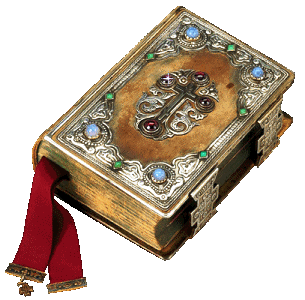
Every Sunday morning in Orthodox Countries (and elsewhere in the world where the law does not forbid it), the church bells solemnly ring to invite the faithful to come together as one family of God--in the Holy House of their Father. Everyone goes to the church for this Great Encounter, where hearts are moved by God’s mercy which is always present, even when we fall. It is also where we forgive those who have hurt us, because if we do not forgive them, then God will not forgive us. The priests and deacons also prepare, with a special short Service, so that their souls can worthily serve the Mystery of the Eucharist. They also ask forgiveness from everyone around them, and once vested according to their rank, prepare to offer the Divine Liturgy.
A few points to note:
In the Orthodox Church, the Divine Liturgy of St. John Chrysostom (who was the Archbishop of Constantinople) is served most days of the ecclesiastical year, with the exception of ten days where the Divine Liturgy of St. Basil (Archbishop of Caesarea in Cappadocia) is served instead. Both of these Liturgies are very similar, differing only in the content and duration of the Great Prayer of the Anaphora, as well as some other prayers, which are longer in St. Basil’s Divine Liturgy.
Throughout the Divine Liturgy, believers experience (in the present, not past tense) the love of God and all the great things He has done for the salvation of humanity. In the Great Prayer of the Anaphora these works of God are mentioned in detail: the creation of man, his life in Paradise, the deception of Satan in the form of a serpent, the loss of paradise, the guidance of the people by the Prophets, and the protection given by the Angels. There are also the miracles with which God saved the people in times of hard trials, such as hunger, thirst, disease, wars, and calamities. Finally, there is the coming of the Savior Christ to earth, the revelation of the truth of His Gospel, His sacrifice on Calvary, the Three-Day Burial, the descent into Hades to free the souls from the tyranny of the devil, His glorious Resurrection and His Ascension in all His glory to Heaven.
What is most amazing, is that we do not recall all of this just to express gratitude to God, but through the liturgical conception of time, all of these world-saving events have been incorporated and harmonized in the Divine Liturgy. We enjoy their blessings in the here and now. As the Church Fathers write, the whole life of Christ unfolds before our eyes. The presence of the future Kingdom is emphasized: "For You, O God... brought us out of nothing into being, and when we had fallen away, You raised us up again. You left nothing undone until you had led us up to heaven and granted us Your Kingdom, which is to come” (The Prayer of the Anaphora of the Liturgy of St. John Chrysostom). After this prayer of thanksgiving we implore the Father of lights to send the Comforter, the Holy Spirit, to sanctify the offering of the Son. The Holy Spirit comes with this mysterious miracle: Giving us Christ in the form of Bread and Wine, so that we can easily partake of Him. An incomprehensible Mystery similar to the Mystery of the Incarnation of the Son of God (”from the Holy Spirit and the Virgin Mary”) takes place.
With the enlightenment of God and the guidance of our inspired Holy Fathers, let us work to understand what is happening during the Divine Liturgy in this next series of sermons.
To start, the Service of the Divine Liturgy consists of two basic Parts. The first part is called the Liturgy of the Cathechumens, and the second the Liturgy of the Faithful, which is the Mystery of the Eucharist.
The first Part begins with the exclamation of the Priest: "Blessed is the Kingdom of the Father and of the Son and of the Holy Spirit, now and forever and to the ages of ages." At the same time, the Priest, after having prostrated before the Holy Table three times and embracing the Holy Gospel, takes it with both hands and raises it, signing with it the sign of the Cross above the Holy Table, as you will surely all have noticed. All the faithful, at that moment, bow to the Holy Gospel making the sign of the cross reverently, and participate in the Amen.
The first Part of the Divine Liturgy includes:
- The Litany of Peace
- The Antiphons
- The Small Entrance with the Holy Gospel
- The Trisagion Hymn
- The Holy Readings
- The Sermon
- The Litanies
- The prayers for the Catechumens
We will begin to look more closely at all of these- God willing - from next Sunday.





